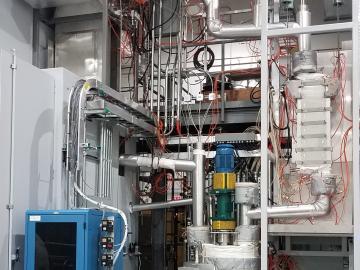
Filter News
Area of Research
- (-) Clean Energy (522)
- (-) Energy Sciences (5)
- (-) Fusion and Fission (54)
- Advanced Manufacturing (34)
- Biological Systems (18)
- Biology and Environment (177)
- Biology and Soft Matter (5)
- Building Technologies (12)
- Chemical and Engineering Materials (4)
- Chemistry and Physics at Interfaces (11)
- Climate and Environmental Systems (14)
- Computational Biology (6)
- Computational Chemistry (5)
- Computational Engineering (5)
- Computer Science (19)
- Data (1)
- Earth Sciences (1)
- Electricity and Smart Grid (3)
- Energy Frontier Research Centers (14)
- Fossil Energy (3)
- Fuel Cycle Science and Technology (3)
- Functional Materials for Energy (16)
- Fusion Energy (17)
- Geographic Information Science and Technology (3)
- Isotope Development and Production (3)
- Isotopes (35)
- Materials (433)
- Materials Characterization (2)
- Materials for Computing (36)
- Materials Synthesis from Atoms to Systems (13)
- Materials Under Extremes (12)
- Mathematics (1)
- National Security (79)
- Neutron Data Analysis and Visualization (4)
- Neutron Science (190)
- Nuclear Science and Technology (74)
- Nuclear Systems Modeling, Simulation and Validation (3)
- Nuclear Systems Technology (1)
- Quantum Condensed Matter (4)
- Quantum information Science (9)
- Reactor Technology (1)
- Renewable Energy (4)
- Sensors and Controls (5)
- Supercomputing (311)
- Transportation Systems (11)
News Type
News Topics
- 3-D Printing/Advanced Manufacturing (78)
- Advanced Reactors (9)
- Artificial Intelligence (9)
- Big Data (5)
- Bioenergy (26)
- Biology (12)
- Biomedical (7)
- Biotechnology (4)
- Buildings (36)
- Chemical Sciences (17)
- Clean Water (8)
- Climate Change (21)
- Composites (17)
- Computer Science (26)
- Coronavirus (12)
- Critical Materials (10)
- Cybersecurity (8)
- Decarbonization (34)
- Energy Storage (74)
- Environment (55)
- Exascale Computing (3)
- Fossil Energy (2)
- Frontier (3)
- Fusion (22)
- Grid (40)
- High-Performance Computing (7)
- Hydropower (2)
- Isotopes (2)
- ITER (6)
- Machine Learning (7)
- Materials (36)
- Materials Science (29)
- Mathematics (2)
- Mercury (3)
- Microelectronics (1)
- Microscopy (9)
- Molten Salt (1)
- Nanotechnology (9)
- National Security (5)
- Net Zero (4)
- Neutron Science (12)
- Nuclear Energy (30)
- Partnerships (13)
- Physics (2)
- Polymers (11)
- Quantum Science (2)
- Renewable Energy (1)
- Security (7)
- Simulation (7)
- Space Exploration (4)
- Statistics (1)
- Summit (4)
- Sustainable Energy (72)
- Transformational Challenge Reactor (3)
- Transportation (66)
Media Contacts

Nine engineers from ORNL visited 10 elementary and middle school classrooms in three school districts during National Engineers Week, Feb. 21 to 24, 2023, describing and demonstrating the excitement of the engineering profession to more than 300 Tennessee students.

Scientists at ORNL developed a competitive, eco-friendly alternative made without harmful blowing agents.

Following months of promising test results, battery researchers at ORNL are recommending that the solid-state battery industry focus on a technique known as isostatic pressing as it looks to commercialize next-generation batteries.

ORNL is teaming with the National Energy Technology Laboratory to jointly explore a range of technology innovations for carbon management and strategies for economic development and sustainable energy transitions in the Appalachian region.

A tool developed by ORNL researchers gives building owners and equipment manufacturers and installers an easy way to calculate the cost savings of a heating and cooling system that utilizes geothermal energy and emits no carbon.

ORNL researchers Ben Ollis and Max Ferrari will be in Adjuntas to join the March 18 festivities but also to hammer out more technical details of their contribution to the project: making the microgrids even more reliable.

ORNL has entered a strategic research partnership with the United Kingdom Atomic Energy Authority, or UKAEA, to investigate how different types of materials behave under the influence of high-energy neutron sources. The $4 million project is part of UKAEA's roadmap program, which aims to produce electricity from fusion.

When aging vehicle batteries lack the juice to power your car anymore, they may still hold energy. Yet it’s tough to find new uses for lithium-ion batteries with different makers, ages and sizes. A solution is urgently needed because battery recycling options are scarce.

Oak Ridge National Laboratory researchers demonstrated that window shades with a cellular or honeycomb structure provide higher energy savings during winter compared to generic venetian blinds and can save millions of tons of carbon emissions.

Scientists at ORNL have begun operating a unique system designed to enable a variety of testing to characterize the performance of an advanced heat transfer fluid for renewable energy


